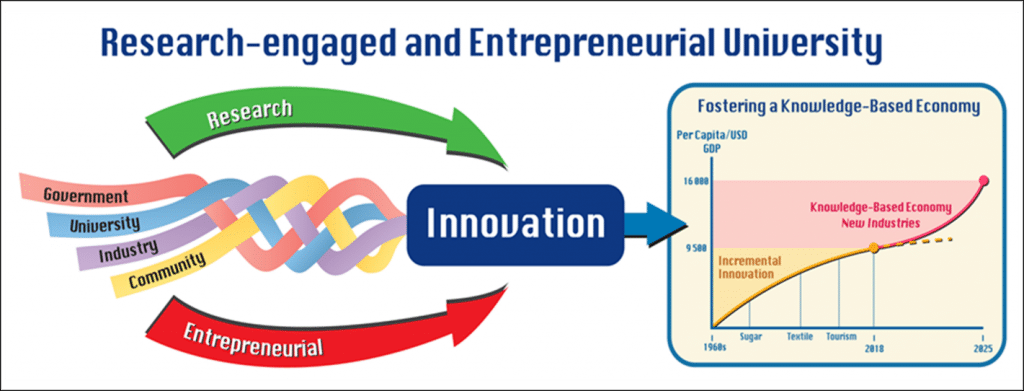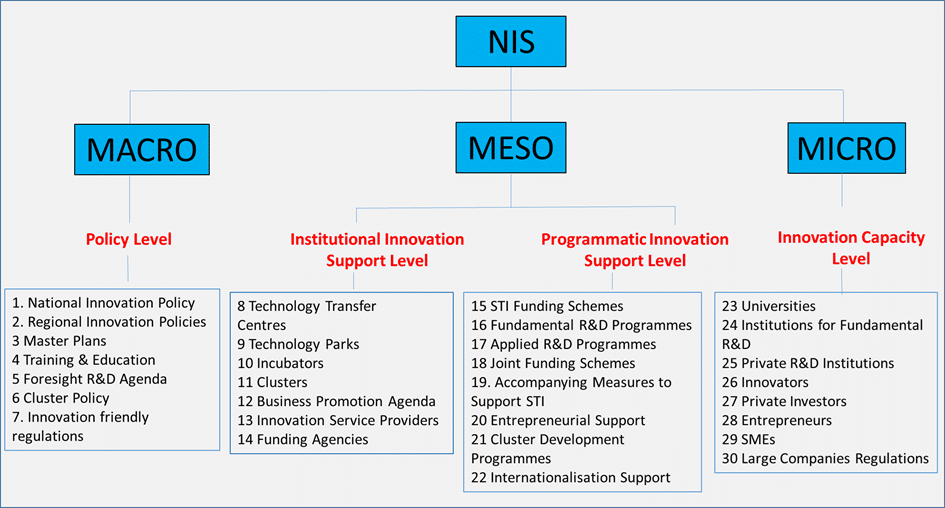Dhanjay Jhurry, Vice-Chancellor, University of Mauritius, Réduit, Mauritius
In this article, Professor Dhanjay Jhurry, Vice-Chancellor of the University of Mauritius (UoM), reviews Mauritius’ innovation shortfalls and some of the UoM’s initiatives to foster research and innovation beyond the traditional research silos. With its poles for research excellence, its poles for Innovation and its Knowledge Transfer Office, the UoM is increasingly producing impactful research and innovation with effective links to industry. To effectively support Mauritius into becoming an innovation driven economy, Dhanjay Jhurry calls for a more integrated national innovation system with, as one key component, the establishment of a cluster of private and public universities partnering and leveraging their respective strengths for the creation of research and knowledge towards identified common goals.
Status of Innovation in Mauritius
The Global Innovation Index(GII) 2020 report points out to a number of weaknesses as regards the innovation performance of Mauritius. Two major weaknesses are (i) business sophistication and (ii) knowledge and technology outputs. Both are intimately linked through their respective key indicators as depicted in Figure 1. The ‘Gross Expenditure on R&D (GERD) financed and performed by business’, ‘University/industry research collaboration’ and ‘Research talent’ together with ‘scientific output’ and ‘high-tech manufacturing’ are key elements that need our urgent attention if we are to develop the k-economy (knowledge economy).
One could also refer to the Innovation Sophistication Index which identifies four stages in the assessment of how innovative a business is, namely – launch, progress, acceleration and achievement. Given Mauritius’ scores in the GII Business Sophistication sub-indices it is reasonable to suspect that the majority of businesses in Mauritius is still in the Launch phase where the need for innovation is recognised but not much has been achieved so far.

Innovation at the University of Mauritius
The University of Mauritius (UoM) has put innovation at the heart of its vision in 2017 through the promotion of a research-engaged and entrepreneurial university, as illustrated in Figure 2. The UoM is a partner of development in close interaction with the public sector, the private sector and the community through a quadruple helix model of innovation. As opposed to a traditional university, the modern UoM caters not only for the human and intellectual capital needs of the country but aspires to develop the business and social capital for progress. As a research-engaged University, our priority research areas align with national priority needs: agriculture, life and marine sciences, health, energy, digital technologies, and socio-economic-tourism. We have institutionalised research and built research teams through Poles of Research Excellence and Poles of Innovation. We are addressing impactful research through a top-down approach that can help solve local problems. Through our Knowledge Transfer Office, we are getting closer to industry and engaging more in innovation. We have set up in October 2018 a UoM-Industry cluster in IT and Digital technologies to precisely address the needs of industry in this growing sector of the Mauritian economy.

National Innovation System
Innovation and technical progress are the result of a complex set of relationships among actors producing, distributing and applying various kinds of knowledge. These actors are primarily private enterprises, universities and public research institutes and the people within them. The innovative performance of a country depends to a large extent on how these actors relate to each other as elements of a collective system of knowledge creation. The absence of a National Innovation System (NIS) is therefore a barrier to the development of the k-economy. In that respect, there is a need, in Mauritius, to develop ways and means to connect the dots and foster institutional linkages, map human resource flows between different sectors and institutions, identify clusters of activities and encourage the emergence of innovative firms. It should be pointed out that Mauritius initiated a National Innovation Framework (NIF) (2018-2030), a programme for creating innovation ecosystems and aimed at invigorating the economy from four perspectives – National, Industry, Company and People. The success of the Innovation Framework was dependent on the synergy and collaborative spirit of the different stakeholders, which would drive multidisciplinary initiatives across organisations. The extent of its implementation and success remains to be assessed but it is undeniable that connecting the dots, i.e. the sectors, remains an issue yet to be tackled holistically.
The proposal for the establishment of a NIS was a major recommendation of the Innovation Week organised by the University of Mauritius in December 2020, heavily supported by both private and public sectors [1]. The proposed NIS is structured into 3 levels: macro, meso and micro, as depicted in Figure 3, which addresses policy issues, the conducive environment and the actions towards enhancing innovation.

Clustering of Universities in Mauritius as key to foster innovation.
Clusters are defined as “a geographically proximate group of interconnected companies and associated institutions in a particular field, linked by commonalities and complementarities” [2]. They can include concentrations of interconnected companies, service providers, suppliers of specialised inputs to the production process, customers, manufacturers of related products and governmental and other institutions, such as national laboratories, universities and research institutes.
Cluster is a term more commonly associated to industry than to academia. However, Universities play key roles in the growth of clusters by providing solutions to business problems through consultancy activity and through the licensing of discoveries to new and existing companies. Universities are important contributors to the development and success of these companies through the skills, knowledge and infrastructure they provide [3]. CLUSTER is an example of such university cluster initiative. It is in this respect that the UoM has set up in 2018 a first cluster around the digital technologies grouping local companies in the sector. However, there is a need to take it to the next level.
In shaping the NIS as discussed earlier, the setting-up of a cluster of local –public and private – Universities is proposed as a means to foster innovation at national level. Such a cluster would focus inter alia on:
- Capturing and nurturing talent
- Leveraging on strengths of different universities and enhancing collaboration
- Optimising and sharing resources, thus promoting efficiency and avoiding duplication
- Establishing research clusters and address multi-disciplinary problems.
The cluster here referred to goes beyond the ‘Leverage/ Exchange’ type of partnership [4] where one organisation recognises that another can provide resources (knowledge, services, skills) that it needs to employ towards its own strategic goals. It is more about the ‘Combine/ Integrate’ type of partnership – a collaboration between organisations where complementary resources are brought together to tackle a common challenge or achieve a shared strategic goal.
Conclusion
In the new normal post-covid19 pandemic, it is important we envision a new culture of university partnership based on complementarity, sharing and a set of principles and values as spelled out in SDG17 ‘Partnerships for the Goals’ [5]. The proposed cluster could be initiated by the universities themselves and should help us in our endeavour to create more impacts and contribute more effectively to the development of Mauritius. It should help also address the weaknesses identified in the GII 2020 report hampering innovation.
References
[1] Innovation Week 2020 Report, University of Mauritius. http://www.uom.ac.mu
[2] Porter, M.E., 1998: On Competition, Harvard Business School Press
[3] Srinatha Karur, M.V.Ramana Murthy. Survey and Analysis of University Clustering, International Journal of Artificial Intelligence & Applications (IJAIA), Vol. 4, No. 4 (2013)
[4] Stibbe, D.T., Reid, S., Gilbert, J.; The Partnering Initiative and UN DESA (2019)
[5] Orazbayeva, B., A. Meerman, V. Galan Muros, T. Davey, C. Plewa. The Future of Universities Thoughtbook Universities during times of crisis; UIIN (2020). p.102.
Main photo by Alina Grubnyak/Unsplash
The Charles Telfair Centre is non-profit, independent and non-partisan, and takes no specific position. All opinions are those of the authors/contributors only.

